Numerical Investigation of Microchannel Heat Sink with Trefoil Shape Ribs
Abstract
:1. Introduction
2. Materials and Methods
2.1. Geometrical Shape of MCHS
2.2. Governing Equations
2.3. Numerical Method and Mesh Independence
2.4. Data Reduction
3. Results
3.1. Model Validation
3.2. Characteristics of Temperature and Pressure Distribution
3.3. Performance Comparison
4. Conclusions
- The addition of trefoil ribs to any wall improved heat transfer characteristic (h and Nu) of MC-SC; the improvement was greater in MC-AWTR followed by MC-SWTR and minimum for MC-BWTR.
- The addition of ribs to any wall has increased the friction factor and, hence, the pumping power. This increase is minimum for MC-BWTR and maximum for MC-AWTR, whereas MC-SWTR is moderate. The addition of ribs improves heat transfer at the expense of an increase in the friction factor (pumping power), which is quantified in terms of η. This factor was higher than one in each case, except for MC-AWTR in 100 < Re < 200. The η for the ribbed channel was highest for MC-SWTR followed by MC-BWTR and lowest for MC-AWTR.
- Although the heat transfer capability of MC-AWTR is superior to others, its overall performance is inferior, thereby confirming that the heat transfer coefficient is not the only criteria for modification of MC-SC. On the other hand, the overall heat transfer enhancement of MC-SWTR was higher than any other case throughout the study, and its value was significantly high in Re > 700.
- Moreover, η increases with Re for each case, which confirms that the increment in Nu with Re is more significant than the increment in . The highest η value of 1.6 is attained for MC-SWTR at Re = 1000. By contrast, the lowest value of 0.87 was achieved for MC-AWTR at Re = 100.
Author Contributions
Funding
Institutional Review Board Statement
Informed Consent Statement
Data Availability Statement
Acknowledgments
Conflicts of Interest
Nomenclature
| MCHS | Microchannel heat sink |
| MC-AWTR | All wall trefoil ribbed microchannel |
| MC-AWSR | Side wall trefoil ribbed microchannel |
| MC-AWBR | Base wall trefoil ribbed microchannel |
| Re | Reynolds number |
| Nu | Nusselt number |
| f | Friction factor |
| L | Length of the MCHS (mm) |
| Hch | Height of the channel (mm) |
| Wch | Width of the channel (mm) |
| Dh | Hydraulic diameter (mm) |
| ΔT | Temperature difference (K) |
| ∆p | Pressure drop (Pa) |
| qw | Wall flux (W/cm2) |
| Cp | Specific heat capacity at constant pressure (J/kg K) |
| µ | Dynamic viscosity (kg/ms) |
| k | Thermal conductivity (W/mK) |
| ρ | Density (kg/m3) |
| η | Thermal enhancement factor |
References
- Xu, M.; Lu, H.; Gong, L.; Chai, J.C.; Duan, X. Parametric numerical study of the flow and heat transfer in microchannel with dimples. Int. Commun. Heat Mass Transf. 2016, 76, 348–357. [Google Scholar] [CrossRef] [Green Version]
- Tuckerman, D.B.; Pease, R.F.W. High-performance heat sinking for VLSI. IEEE Electron Device Lett. 1981, 2, 126–129. [Google Scholar] [CrossRef]
- Ahmad, F.; Cheema, T.A.; Ur Rehman, M.M.; Abbas, A.; Woo Park, C. Thermal enhancement of microchannel heat sink using rib surface refinements. Numer. Heat Transf. Part A Appl. 2019, 76, 851–870. [Google Scholar] [CrossRef]
- Liu, X.; Yu, J. Numerical study on performances of mini-channel heat sinks with non-uniform inlets. Appl. Therm. Eng. 2016, 93, 856–864. [Google Scholar] [CrossRef]
- Rehman, M.M.U.; Cheema, T.A.; Ahmad, F.; Khan, M.; Abbas, A. Thermodynamic Assessment of Microchannel Heat Sinks with Novel Sidewall Ribs. J. Thermophys. Heat Transf. 2020, 34, 243–254. [Google Scholar] [CrossRef]
- Ali, S.; Ahmad, F.; Hassan, M.; Rehman, Z.; Wadood, A.; Ahmad, K.; Park, H. Thermo-fluid Characteristics of Microchannel Heat Sink with Multi-configuration NACA 2412 Hydrofoil Ribs. IEEE Access 2021, 9, 128407–128416. [Google Scholar] [CrossRef]
- Rehman, M.M.U.; Cheema, T.A.; Ahmad, F.; Abbas, A.; Malik, M.S. Numerical investigation of heat transfer enhancement and fluid flow characteristics in a microchannel heat sink with different wall/design configurations of protrusions/dimples. Heat Mass Transf. 2020, 56, 239–255. [Google Scholar] [CrossRef]
- Zhu, Q.; Chang, K.; Chen, J.; Zhang, X.; Xia, H.; Zhang, H.; Wang, H.; Li, H.; Jin, Y. Characteristics of heat transfer and fluid flow in microchannel heat sinks with rectangular grooves and different shaped ribs. Alex. Eng. J. 2020, 59, 4593–4609. [Google Scholar] [CrossRef]
- Xiao, H.; Liu, Z.; Liu, W. Turbulent heat transfer enhancement in the mini-channel by enhancing the original flow pattern with v-ribs. Int. J. Heat Mass Transf. 2020, 163, 120378. [Google Scholar] [CrossRef]
- Hassani, S.M.; Khoshvaght-Aliabadi, M.; Mazloumi, S.H.; Rehman, S.; Alimoradi, A. Improving thermal performance of microchannels by combining rectangular pin with chamber. Appl. Therm. Eng. 2021, 186, 116373. [Google Scholar] [CrossRef]
- Ahmad, F.; Cheema, T.A.; Mohib Ur Rehman, M.; Ilyas, M.; Park, C.W. Thermodynamic analysis of microchannel heat sink with cylindrical ribs and cavities. J. Heat Transf. 2020, 142, 092503. [Google Scholar] [CrossRef]
- Yang, D.; Jin, Z.; Wang, Y.; Ding, G.; Wang, G. Heat removal capacity of laminar coolant flow in a micro channel heat sink with different pin fins. Int. J. Heat Mass Transf. 2017, 113, 366–372. [Google Scholar] [CrossRef]
- Naqiuddin, N.H.; Saw, L.H.; Yew, M.C.; Yusof, F.; Ng, T.C.; Yew, M.K. Overview of micro-channel design for high heat flux application. Renew. Sustain. Energy Rev. 2018, 82, 901–914. [Google Scholar] [CrossRef]
- Wang, G.; Chen, T.; Tian, M.; Ding, G. Fluid and heat transfer characteristics of microchannel heat sink with truncated rib on sidewall. Int. J. Heat Mass Transf. 2020, 148, 119142. [Google Scholar] [CrossRef]
- Chuan, L.; Wang, X.D.; Wang, T.H.; Yan, W.M. Fluid flow and heat transfer in microchannel heat sink based on porous fin design concept. Int. Commun. Heat Mass Transf. 2015, 65, 52–57. [Google Scholar] [CrossRef]
- Wang, T.H.; Wu, H.C.; Meng, J.H.; Yan, W.M. Optimization of a double-layered microchannel heat sink with semi-porous-ribs by multi-objective genetic algorithm. Int. J. Heat Mass Transf. 2020, 149, 119217. [Google Scholar] [CrossRef]
- Ahmad, F.; Cheema, T.A.; Khan, A.; Mohib-Ur-Rehman, M.; Yildizhan, H. Hydrothermal Investigation of the Performance of Microchannel Heat Sink with Ribs Employed on Side Walls. J. Non-Equilib. Thermodyn. 2021. [Google Scholar] [CrossRef]
- Moradikazerouni, A.; Afrand, M.; Alsarraf, J.; Mahian, O.; Wongwises, S.; Tran, M.D. Comparison of the effect of five different entrance channel shapes of a micro-channel heat sink in forced convection with application to cooling a supercomputer circuit board. Appl. Therm. Eng. 2019, 150, 1078–1089. [Google Scholar] [CrossRef]
- Karwa, R.; Sharma, C.; Karwa, N. Performance evaluation criterion at equal pumping power for enhanced performance heat transfer surfaces. J. Sol. Energy 2013, 37, 23–32. [Google Scholar] [CrossRef] [Green Version]
- Steinke, M.E.; Kandlikar, S.G. Single-phase liquid friction factors in microchannels. Int. J. Therm. Sci. 2006, 45, 1073–1083. [Google Scholar] [CrossRef]
- Wang, G.; Niu, D.; Xie, F.; Wang, Y.; Zhao, X.; Ding, G. Experimental and numerical investigation of a microchannel heat sink (MCHS) with micro-scale ribs and grooves for chip cooling. Appl. Therm. Eng. 2015, 85, 61–70. [Google Scholar] [CrossRef]

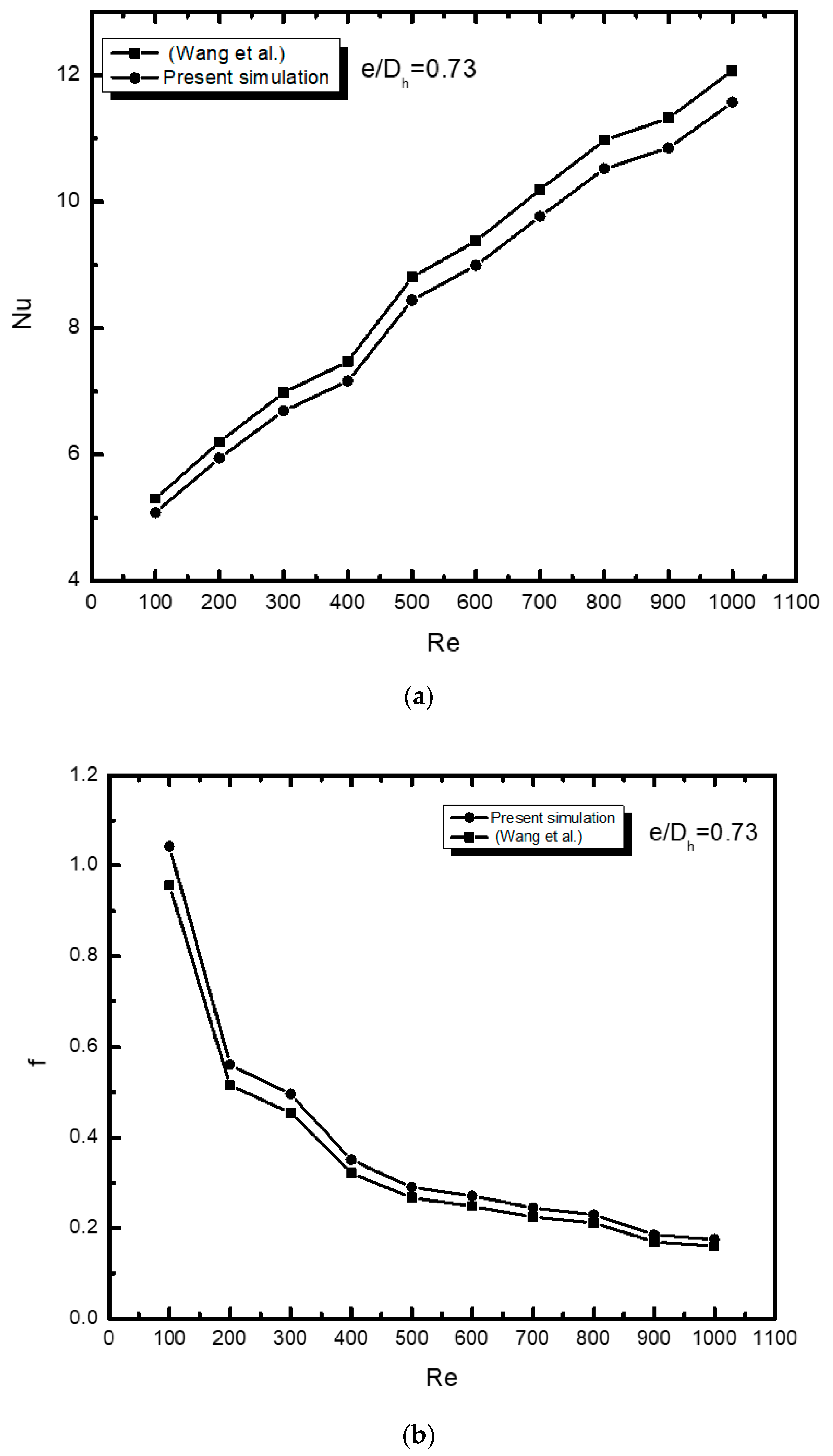

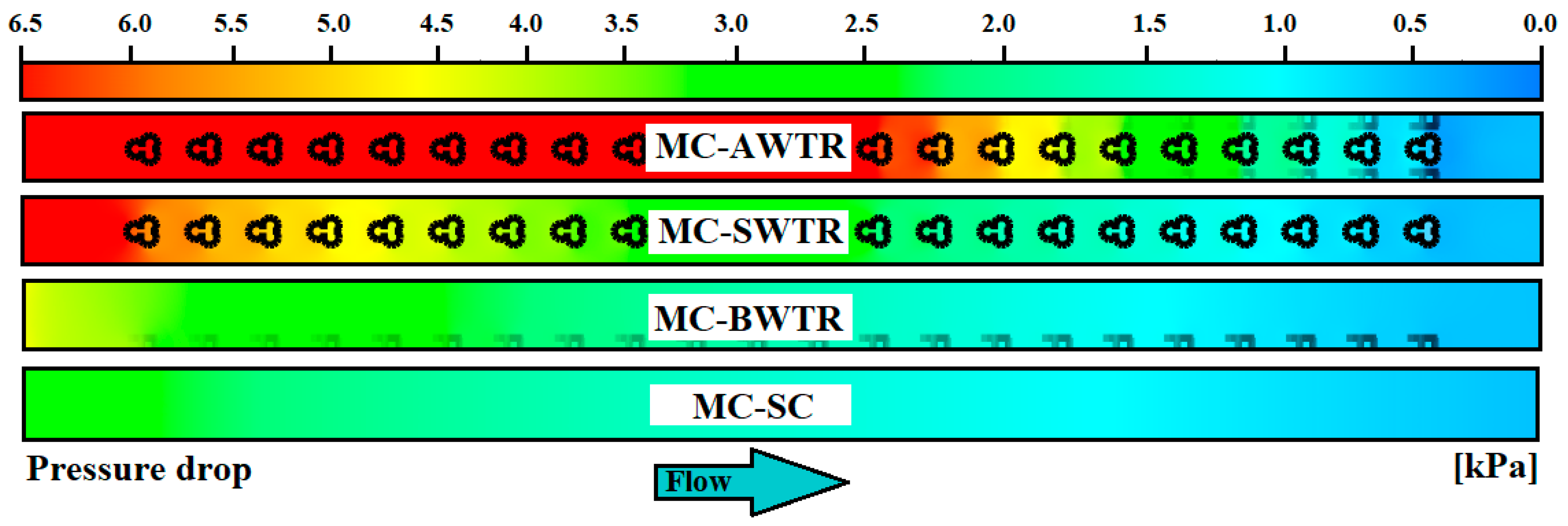
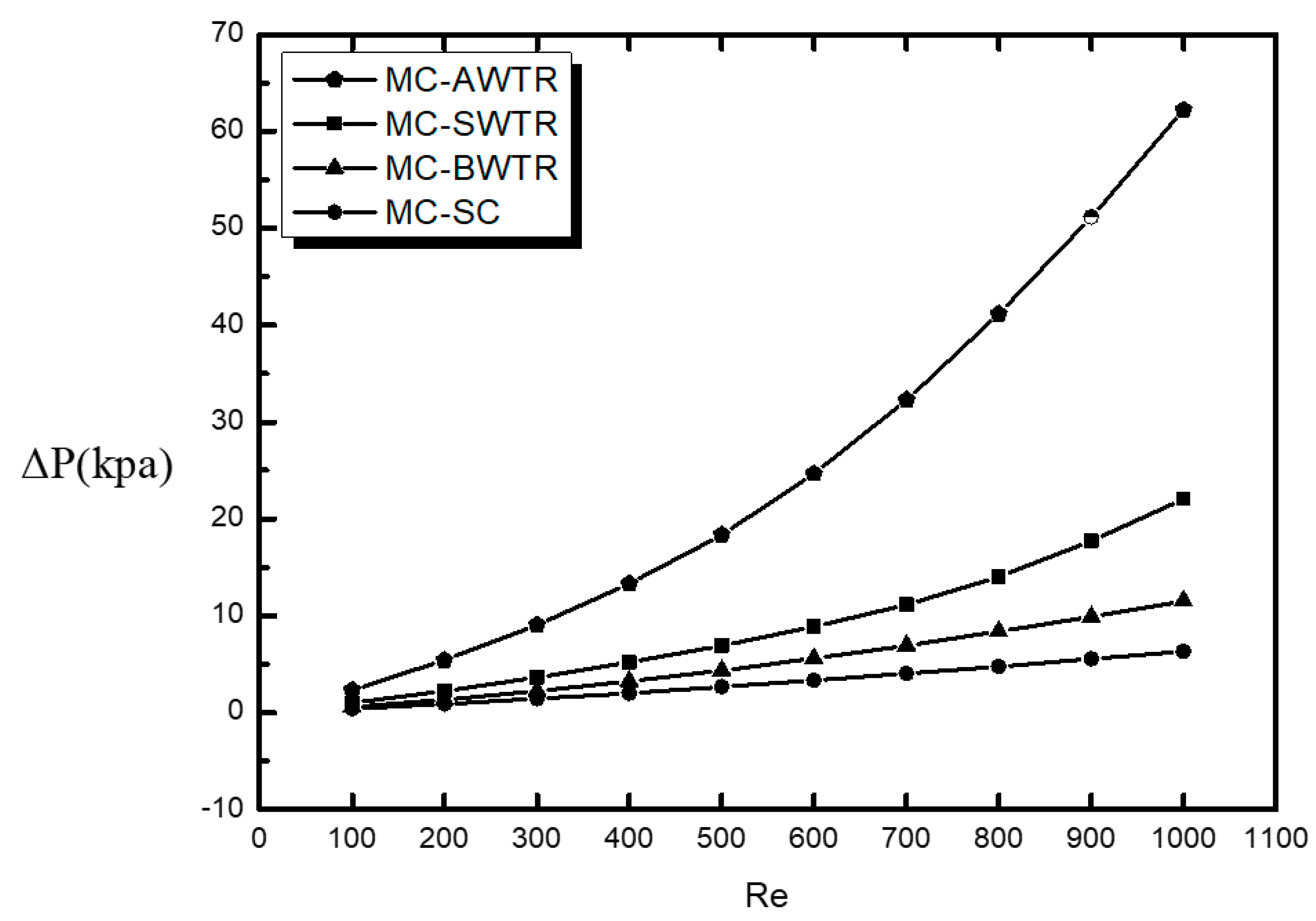

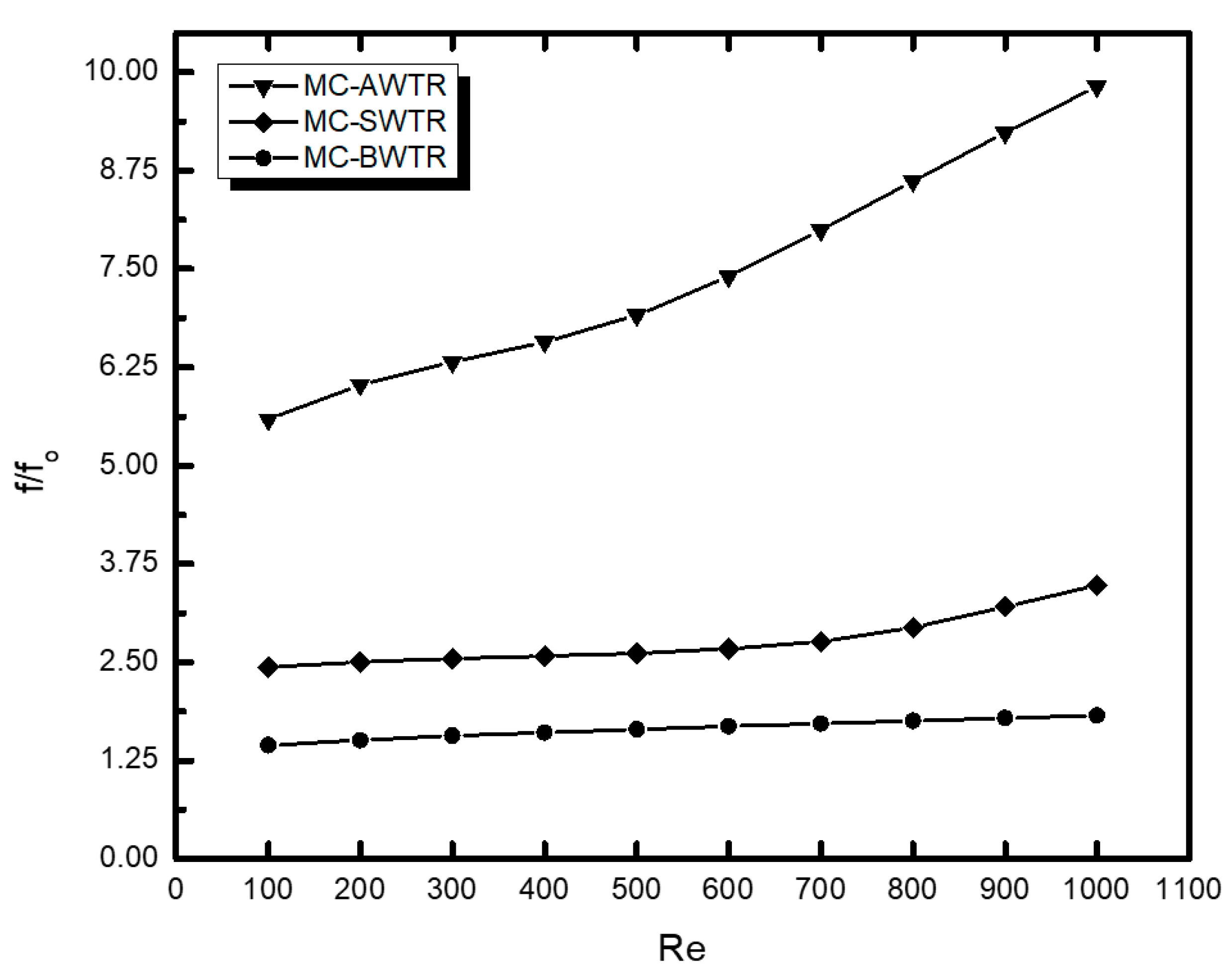

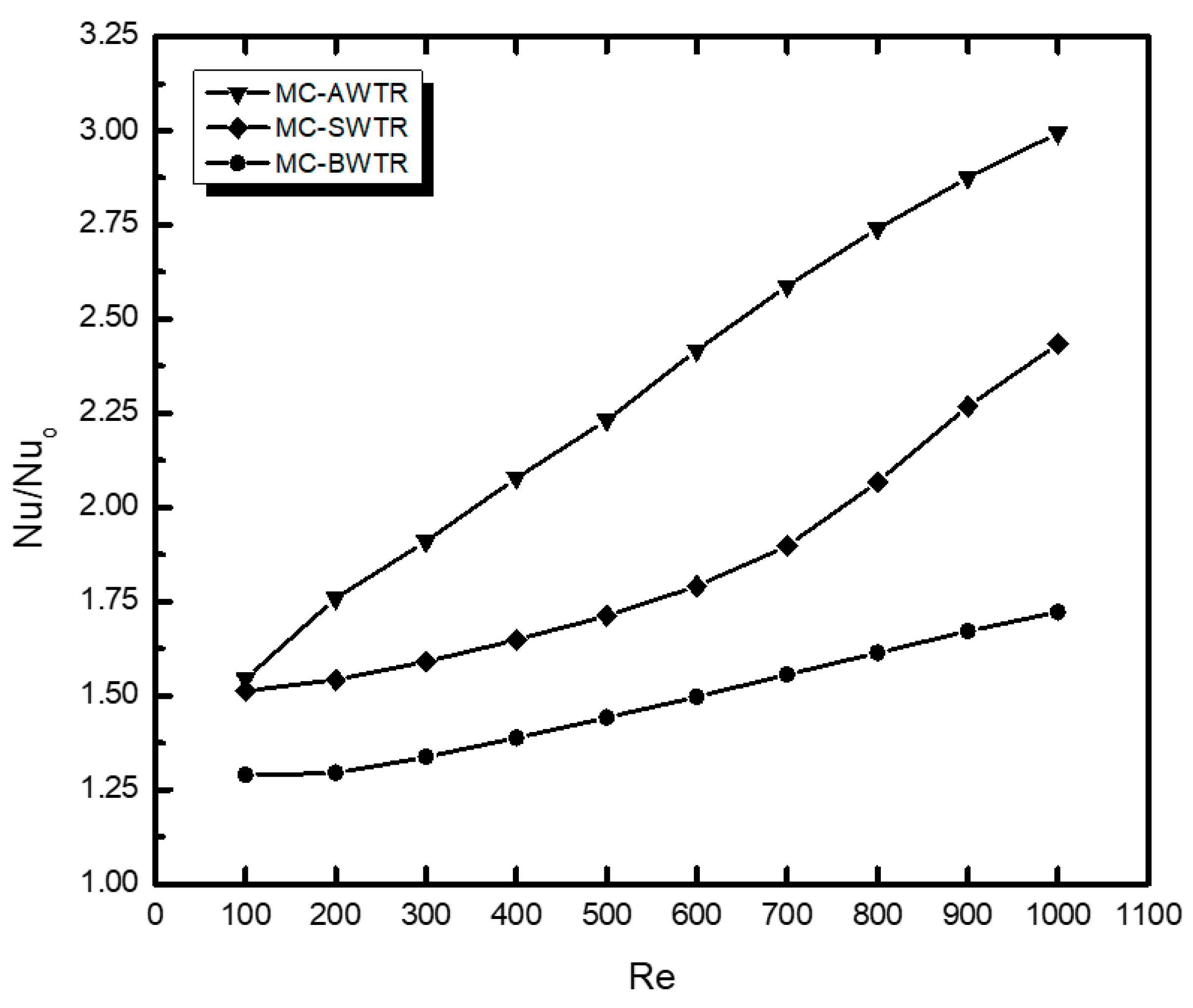

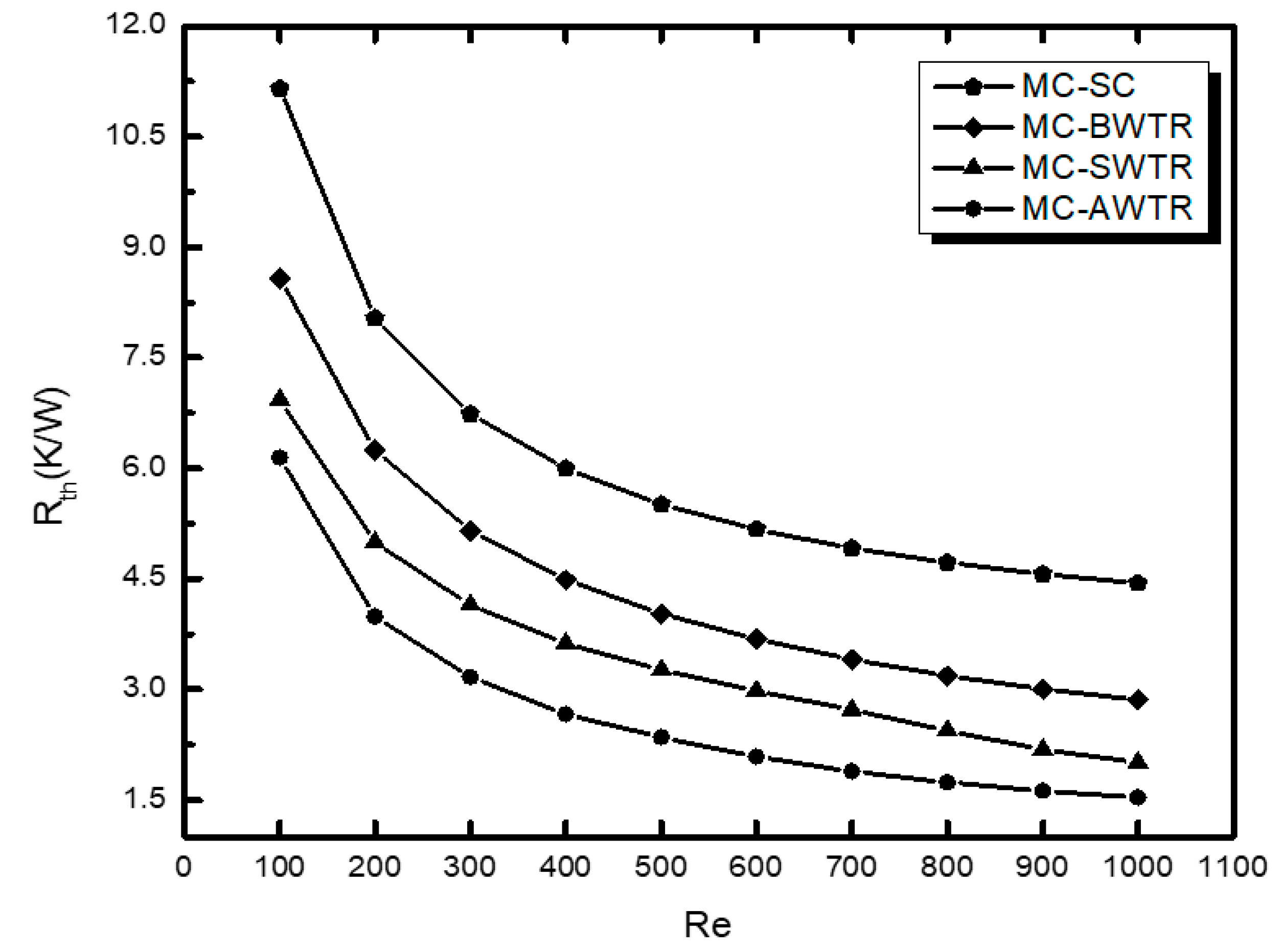
| ρ (kg/m3) | Cp (/kg/K) | k (W/m/K) | µ (kg/m/s) | |
|---|---|---|---|---|
| Copper | 8978 | 381 | 387.6 | |
| Water | 998.2 | 4812 | 0.6 | 0.001003 |
| Mesh No | No of Elements | Pressure Drop (Pa) | Error (%) | Nu | Error (%) |
|---|---|---|---|---|---|
| 1 | 568,956 | 4342.478 | 0.58 | 11.68255 | 0.83 |
| 2 | 691,194 | 4350.475 | 0.34 | 11.65281 | 0.58 |
| 3 | 811,646 | 4360.415 | 0.17 | 11.63914 | 0.46 |
| 4 | 963,976 | 4366.139 | 0.038 | 11.65263 | 0.058 |
| 5 | 1,231,560 | 4367.813 | 11.58557 |
Publisher’s Note: MDPI stays neutral with regard to jurisdictional claims in published maps and institutional affiliations. |
© 2021 by the authors. Licensee MDPI, Basel, Switzerland. This article is an open access article distributed under the terms and conditions of the Creative Commons Attribution (CC BY) license (https://creativecommons.org/licenses/by/4.0/).
Share and Cite
Ali, S.; Ahmad, F.; Akhtar, K.; Habib, N.; Aamir, M.; Giasin, K.; Vafadar, A.; Pimenov, D.Y. Numerical Investigation of Microchannel Heat Sink with Trefoil Shape Ribs. Energies 2021, 14, 6764. https://doi.org/10.3390/en14206764
Ali S, Ahmad F, Akhtar K, Habib N, Aamir M, Giasin K, Vafadar A, Pimenov DY. Numerical Investigation of Microchannel Heat Sink with Trefoil Shape Ribs. Energies. 2021; 14(20):6764. https://doi.org/10.3390/en14206764
Chicago/Turabian StyleAli, Sadiq, Faraz Ahmad, Kareem Akhtar, Numan Habib, Muhammad Aamir, Khaled Giasin, Ana Vafadar, and Danil Yurievich Pimenov. 2021. "Numerical Investigation of Microchannel Heat Sink with Trefoil Shape Ribs" Energies 14, no. 20: 6764. https://doi.org/10.3390/en14206764
APA StyleAli, S., Ahmad, F., Akhtar, K., Habib, N., Aamir, M., Giasin, K., Vafadar, A., & Pimenov, D. Y. (2021). Numerical Investigation of Microchannel Heat Sink with Trefoil Shape Ribs. Energies, 14(20), 6764. https://doi.org/10.3390/en14206764










